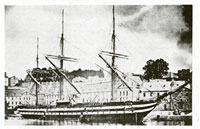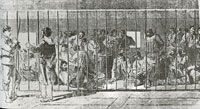Transportation
 Steam engine-assisted windjammers took the prisoners to New Caledonia. In those days the voyage took about three months. The vessels were especially equipped to transport prisoners. They followed a zigzag route in order to profit from Gulf stream and trade wind and crossed the Atlantic twice. They passed the Canaries heading for Senegal, then to Brazil, a second crossing to the African continent to round the Cape of Good Hope, and finally, via Tasmania to Nouméa, the harbor of New Caledonia. This added up to 16,700 sea miles or 30,928 kilometers. Large groups of Algerians were transported on the vessels Loire and Calvados, which arrived on August 16, 1874, and January 18, 1875. Later transports also included a few Algerians: the Garonne (March 12, 1975) and the Rhin (January 30,1876).
Steam engine-assisted windjammers took the prisoners to New Caledonia. In those days the voyage took about three months. The vessels were especially equipped to transport prisoners. They followed a zigzag route in order to profit from Gulf stream and trade wind and crossed the Atlantic twice. They passed the Canaries heading for Senegal, then to Brazil, a second crossing to the African continent to round the Cape of Good Hope, and finally, via Tasmania to Nouméa, the harbor of New Caledonia. This added up to 16,700 sea miles or 30,928 kilometers. Large groups of Algerians were transported on the vessels Loire and Calvados, which arrived on August 16, 1874, and January 18, 1875. Later transports also included a few Algerians: the Garonne (March 12, 1975) and the Rhin (January 30,1876).
"Ordinary" convicts were also on board, but they were separated from the political prisoners. On board the Loire, there was only one communard, 198 ordinary convicts, and 39 Algerians. Only 34 of this latter group survived the voyage, the rest had died on the way and their bodies were thrown overboard. Many of the other prisoners were victims of scurvy. On board the Calvados, there were about 200 French prisoners, 62 Algerians (59 arrived), and 134 crew, including a doctor, a nurse, and a chaplain.
 The prisoners were packed together in large cages, and they slept on collapsible planks. They were put on rations of 800 grams of bread, a quarter liter of wine, bean soup twice a day, meat on Wednesdays and Sundays, and fish or cheese on Fridays. There was no daylight. On departure the prisoners were given a registration number, and during the trip they were addressed with these numbers. In New Caledonia the Algerians were called "les Arabes," but historically they have been recorded as "Kabyles du Pacifique," after the region of their birth, Kabylia.
The prisoners were packed together in large cages, and they slept on collapsible planks. They were put on rations of 800 grams of bread, a quarter liter of wine, bean soup twice a day, meat on Wednesdays and Sundays, and fish or cheese on Fridays. There was no daylight. On departure the prisoners were given a registration number, and during the trip they were addressed with these numbers. In New Caledonia the Algerians were called "les Arabes," but historically they have been recorded as "Kabyles du Pacifique," after the region of their birth, Kabylia.
